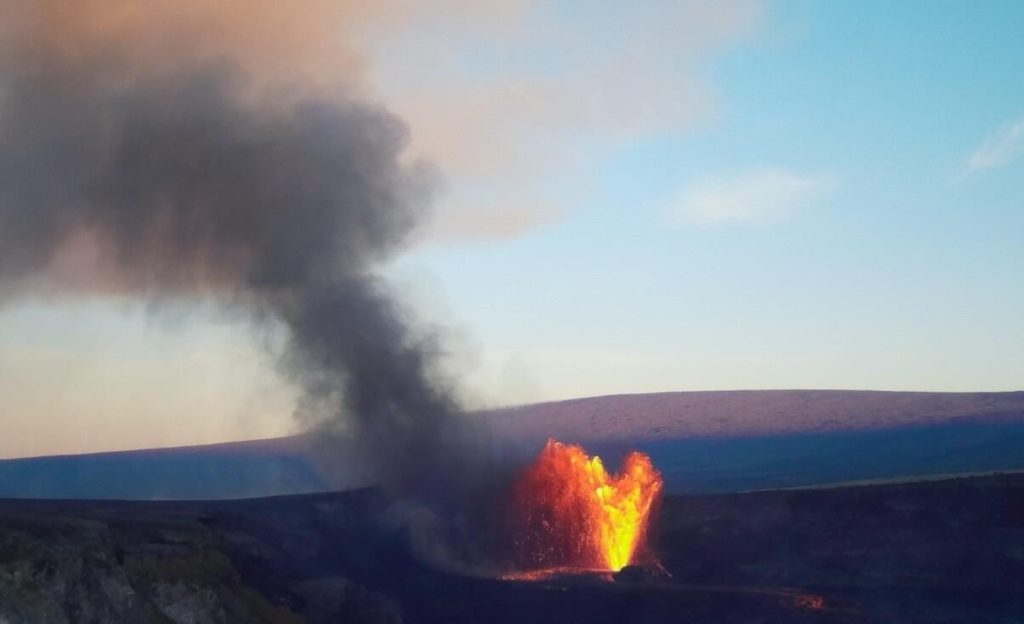Volcano Watch: Remembering a destructive Mauna Loa eruption 75 years ago
“Volcano Watch” is a weekly article and activity update written by U.S. Geological Survey Hawaiian Volcano Observatory scientists and affiliates.
Lava fountains at the summit of Kīlauea on the Big Island have been shining a spotlight on Hawai’i’s most active volcano, but let’s not forget the larger one looming in Kīlauea’s background.
Mauna Loa is now quiet, so it’s a good opportunity to remember the 1950 Southwest Rift Zone eruption — the volcano’s most recent eruption to cause significant damage — 75 years ago.

Mauna Loa erupted frequently prior to 1950. Consistent written records of Mauna Loa eruptions begin in 1843. Between then and 1950, there were 30, meaning that before 1950, Mauna Loa erupted on average every 3 to 4 years.
Fast forward to 2025 and there have been only three eruptions during the past 75 years since: 1975, 1984 and 2022.
While the frequency of eruptions has decreased since 1950 compared to the century before, Mauna Loa remains an active volcano that will erupt again someday.
Eruptions of Mauna Loa generally start high in the summit region, above 12,000 feet in elevation. From there, eruptions can migrate into one of the two rift zones — the Northeast Rift Zone or Southwest Rift Zone — or, less commonly, radial vents on the volcano’s northwest flank.
Mauna Loa inflation because of magma accumulating beneath the surface was evident on monitoring stations during the spring of 1950 at the summit of Kīlauea.
Seismic activity under Mauna Loa increased in May of that year, with the largest earthquake — a magnitude-6.4 temblor — happening May 29.
A swarm of earthquakes shook the volcano June 1, and the night sky was illuminated at 9:25 p.m. with red glow as a fissure system 2.5 miles long opened high on the southwest flank of Mauna Loa’s summit region.
Activity at the initial fissure system lasted just a few hours, and lava flows stalled at about 9,000 feet in elevation. Soon after, two other sets of fissure vents opened lower on the Southwest Rift Zone, between 10,500 and 8,500 feet and 8,200 and 7,810 feet in elevation.
Lava fountains nearly 200 feet high fed a system of complex braided lava flows moving nearly 5 miles per hour down Mauna Loa’s steep west flanks.
About 3 hours after those lower fissures opened, the first lava flow crossed Highway 11 and entered the ocean, destroying a gas station, post office and several homes along the way.
Fourteen and a half hours after the eruption began, another lava flow crossed Highway 11. This second flow destroyed several homes and entered the ocean about 1.2 miles south of the first flow.
Activity at both lava flows and their ocean entries ceased within about a day.
Yet another set of fissure vents opened even lower on the volcano later the night of June 1, between 8,200 and 7,810 feet in elevation. A lava flow from this fissure entered the ocean by the afternoon of June 2, farther south than the two earlier flows.
Lava would drain from Mauna Loa for the next 3 weeks via this channelized lava flow into the ocean.
Before the eruption ended June 23, Hoʻokena village was destroyed, including a post office, church, gas station, cemetery and at least 5 homes.
Structures of the Magoon Ranch, ʻŌhiʻa Lodge and several other vacation/fishing cottages were also destroyed. Lava flows crossed Highway 11 in three locations.
One man — who was looking after cattle on a ranch — was trapped between two lava flows for 28 hours before being rescued by the U.S. Coast Guard.
Thirty-five homestead lots were later opened in Kona for people whose property had been covered by lava in 1950.
The 1950 eruption was the largest-volume eruption of Mauna Loa’s Southwest Rift Zone since written records began; lava flows moved quickly down steep slopes in the region to enter the ocean within hours of the eruption onset.
Mauna Loa has been quiet since the 2022 Northeast Rift Zone eruption, but monitoring data indicates magma is slowly accumulating within the volcano.
As communities on the flanks of Mauna Loa continue to grow, Hawaiʻi Island residents should not forget these past eruptions.
While 75 years is a long time to humans, it goes by in the blink of an eye for an active volcano.
Volcano Activity Updates
Kīlauea has been erupting episodically within its summit caldera since Dec. 23, 2024. Its U.S. Geological Survey Volcano Alert Level Remains at Watch.
Episode 28 of the ongoing eruption happened July 9, with about 9 hours of fountaining from the north vent. Summit region inflation since the end of Episode 28, along with persistent tremor, suggests another episode is possible.
Current inflation data indicate Episode 29 is likely to start between July 17 and 18.
Sulfur dioxide emission rates are elevated in the summit region during active eruption episodes. No unusual activity has been noted along Kīlauea’s East Rift Zone or Southwest Rift Zone.
Mauna Loa is not erupting. Its U.S. Geological Survey Volcano Alert Level remains at Normal.
One earthquake was reported felt in the Hawaiian Islands during the past week:
- MAGNITUDE-3 located 3 miles south-southwest of Pāhala at a depth of 19 miles at 6:14 p.m. July 15.
Hawaiian Volcano Observatory continues to closely monitor Kīlauea and Mauna Loa.
Visit the volcano observatory website for past “Volcano Watch” articles, Kīlauea and Mauna Loa updates, volcano photos, maps, recent earthquake information and more. Email questions to askHVO@usgs.gov.



